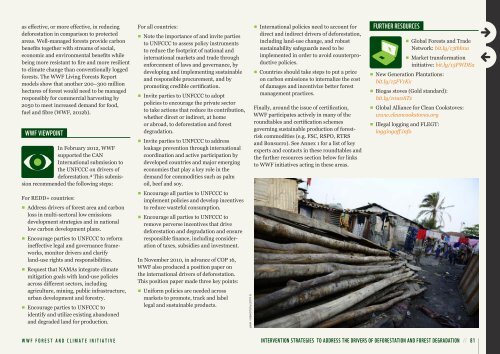WWF Guide to Building REDD+ Strategies
WWF Guide to Building REDD+ Strategies
WWF Guide to Building REDD+ Strategies
You also want an ePaper? Increase the reach of your titles
YUMPU automatically turns print PDFs into web optimized ePapers that Google loves.
as effective, or more effective, in reducing<br />
deforestation in comparison <strong>to</strong> protected<br />
areas. Well-managed forests provide carbon<br />
benefits <strong>to</strong>gether with streams of social,<br />
economic and environmental benefits while<br />
being more resistant <strong>to</strong> fire and more resilient<br />
<strong>to</strong> climate change than conventionally logged<br />
forests. The <strong>WWF</strong> Living Forests Report<br />
models show that another 200–300 million<br />
hectares of forest would need <strong>to</strong> be managed<br />
responsibly for commercial harvesting by<br />
2050 <strong>to</strong> meet increased demand for food,<br />
fuel and fibre (<strong>WWF</strong>, 2012b).<br />
<strong>WWF</strong> vieWPoint<br />
In February 2012, <strong>WWF</strong><br />
supported the CAN<br />
International submission <strong>to</strong><br />
the UNFCCC on drivers of<br />
deforestation.⁴ This submission<br />
recommended the following steps:<br />
For <strong>REDD+</strong> countries:<br />
n Address drivers of forest area and carbon<br />
loss in multi-sec<strong>to</strong>ral low emissions<br />
development strategies and in national<br />
low carbon development plans.<br />
n Encourage parties <strong>to</strong> UNFCCC <strong>to</strong> reform<br />
ineffective legal and governance frameworks,<br />
moni<strong>to</strong>r drivers and clarify<br />
land-use rights and responsibilities.<br />
n Request that NAMAs integrate climate<br />
mitigation goals with land-use policies<br />
across different sec<strong>to</strong>rs, including<br />
agriculture, mining, public infrastructure,<br />
urban development and forestry.<br />
n Encourage parties <strong>to</strong> UNFCCC <strong>to</strong><br />
identify and utilize existing abandoned<br />
and degraded land for production.<br />
<strong>WWF</strong> FOREST AND CLIMATE INITIATIVE<br />
For all countries:<br />
n Note the importance of and invite parties<br />
<strong>to</strong> UNFCCC <strong>to</strong> assess policy instruments<br />
<strong>to</strong> reduce the footprint of national and<br />
international markets and trade through<br />
enforcement of laws and governance, by<br />
developing and implementing sustainable<br />
and responsible procurement, and by<br />
promoting credible certification.<br />
n Invite parties <strong>to</strong> UNFCCC <strong>to</strong> adopt<br />
policies <strong>to</strong> encourage the private sec<strong>to</strong>r<br />
<strong>to</strong> take actions that reduce its contribution,<br />
whether direct or indirect, at home<br />
or abroad, <strong>to</strong> deforestation and forest<br />
degradation.<br />
n Invite parties <strong>to</strong> UNFCCC <strong>to</strong> address<br />
leakage prevention through international<br />
coordination and active participation by<br />
developed countries and major emerging<br />
economies that play a key role in the<br />
demand for commodities such as palm<br />
oil, beef and soy.<br />
n Encourage all parties <strong>to</strong> UNFCCC <strong>to</strong><br />
implement policies and develop incentives<br />
<strong>to</strong> reduce wasteful consumption.<br />
n Encourage all parties <strong>to</strong> UNFCCC <strong>to</strong><br />
remove perverse incentives that drive<br />
deforestation and degradation and ensure<br />
responsible finance, including consideration<br />
of taxes, subsidies and investment.<br />
In November 2010, in advance of COP 16,<br />
<strong>WWF</strong> also produced a position paper on<br />
the international drivers of deforestation.<br />
This position paper made three key points:<br />
n Uniform policies are needed across<br />
markets <strong>to</strong> promote, track and label<br />
legal and sustainable products.<br />
© JULIE PUDLOWSKI / <strong>WWF</strong><br />
n International policies need <strong>to</strong> account for<br />
direct and indirect drivers of deforestation,<br />
including land-use change, and robust<br />
sustainability safeguards need <strong>to</strong> be<br />
implemented in order <strong>to</strong> avoid counterproductive<br />
policies.<br />
n Countries should take steps <strong>to</strong> put a price<br />
on carbon emissions <strong>to</strong> internalize the cost<br />
of damages and incentivize better forest<br />
management practices.<br />
Finally, around the issue of certification,<br />
<strong>WWF</strong> participates actively in many of the<br />
roundtables and certification schemes<br />
governing sustainable production of forestrisk<br />
commodities (e.g. FSC, RSPO, RTRS<br />
and Bonsucro). See Annex 1 for a list of key<br />
experts and contacts in these roundtables and<br />
the further resources section below for links<br />
<strong>to</strong> <strong>WWF</strong> initiatives acting in these areas.<br />
FuRtHeR ReSouRCeS<br />
n Global Forests and Trade<br />
Network: bit.ly/13thhna<br />
n Market transformation<br />
initiative: bit.ly/15FWDEa<br />
n New Generation Plantations:<br />
bit.ly/15FV1Kx<br />
n Biogas s<strong>to</strong>ves (Gold standard):<br />
bit.ly/10u0ATz<br />
n Global Alliance for Clean Cooks<strong>to</strong>ves:<br />
www.cleancooks<strong>to</strong>ves.org<br />
n Illegal logging and FLEGT:<br />
loggingoff.info<br />
inteRvention StRateGieS <strong>to</strong> addReSS tHe dRiveRS oF deFoReStation and FoReSt deGRadation // 81

















